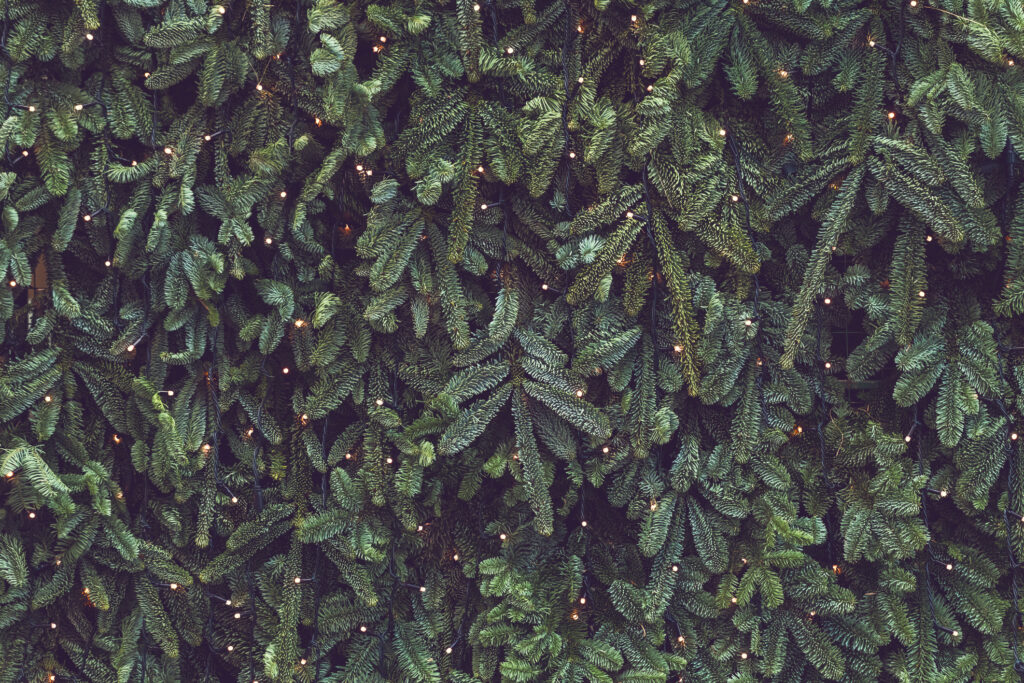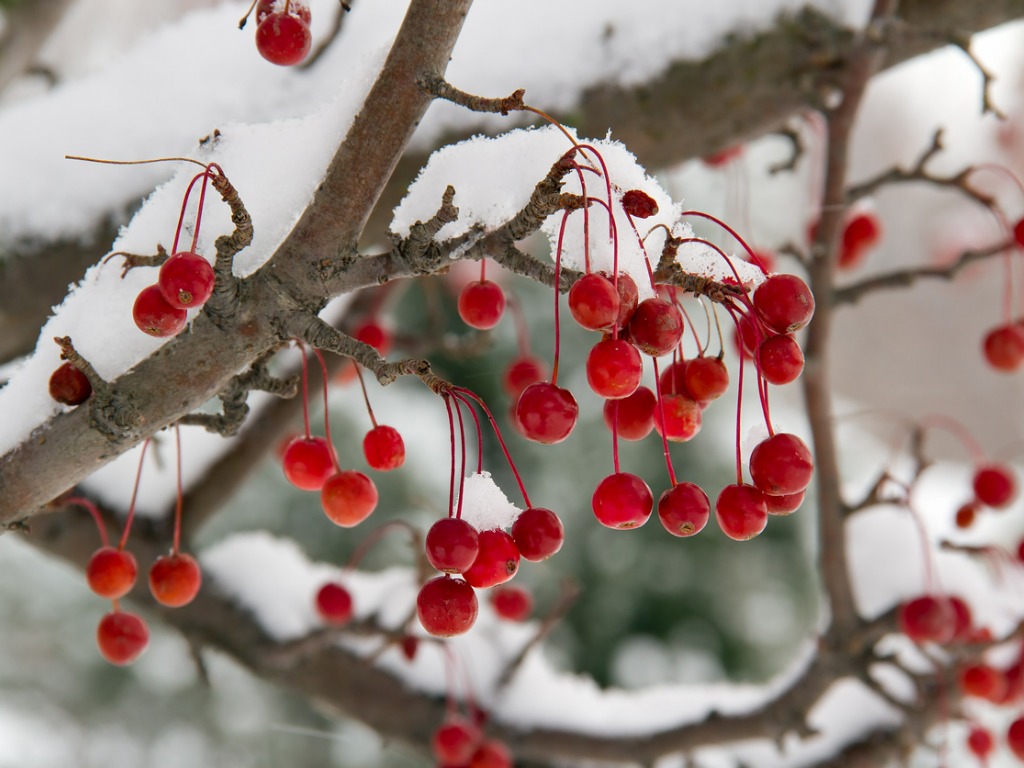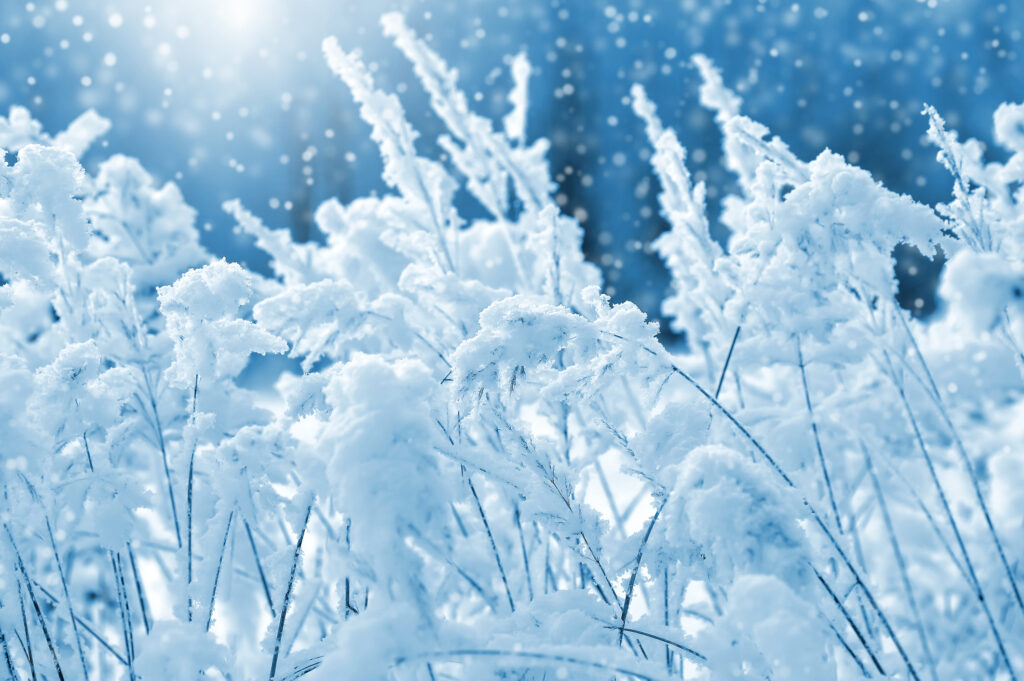
Winter can be dreary but also beautiful. In the Midwest, we enjoy the snow that blankets our gardens, creating a peaceful scene for us to enjoy. However, our long winters often have us looking for additional beauty in our landscape. You can use a variety of trees, shrubs, and perennials to add interest to the garden using features that include peeling bark, seedheads, or colorful stems. One example is the River Birch (Betula nigra). My parents have this tree in their yard, and it always stands out when I visit them. The peeling bark is also multicolored, adding to its unique look. It looks good in every season but pops in the winter. As a bonus, this species often has multiple trunks, giving you a larger tree to enjoy.
Evergreens

Evergreens are beautiful plants for winter interest and come in many forms. Eastern White Pine (Pinus strobus) is among our most prominent evergreens, featuring soft feathery needles that gracefully move in the wind. Like the river birch, this pine is native to the Midwest, making it easy to grow in our harsh climate. For small landscapes, consider a dwarf evergreen, like the Pancake arborvitae. It grows only 12 inches tall and may be used in various spaces. You can have several types of arbor vitae, ranging from 3-20 ft tall. These often-narrow trees make excellent screens or windbreaks for smaller properties.
Spruce and fir are beautiful trees in the northern landscape. Balsam fir (Abies balsemea) is commonly grown for Christmas trees, but its shiny needles also look good in the yard. Black hills spruce can be planted in groups or as a specimen, as they look similar to balsam fir. Like any trees, evergreens should receive supplemental watering in their first couple of years after planting.
Trees are just some of the evergreens that look good in winter. Boxwood and yew stay compact and can be used along foundations and sidewalks to add year-round greenery. You should plant these shrubs in sheltered locations to prevent the leaves from drying.
Another evergreen shrub is the rhododendron, known for its spring pink flowers. Unlike other evergreens, the leaves of this shrub curl in the winter to conserve moisture. The name for this unique process is thermonasty, an exciting word I never heard until horticulture class in college. Rhododendron must have acidic soil to thrive, a lesson I’ve learned the hard way. Consider testing the soil in your landscape if you need clarification on the acidity levels. Soil tests will also help you determine other possible needs for your soil.
Shrubs and Small Trees

Winter interest comes in many forms, including fruit. Certain crabapple trees will retain fruit through fall and winter, including ‘Royal Raindrops‘ and ‘Firebirds’. These ornamental trees come in many shapes and sizes, allowing you to use them in group plantings or as a specimen. Birds enjoy the fruit as well.
A unique shrub to consider is winterberry (Illex verticillata). This type of holly is hardy to zone 3 and drops its leaves for winter. In autumn, the leaves fall to reveal bright red berries that densely cover the shrub. Winterberry should be planted in groups that contain both a male and female cultivar to produce fruit. An excellent shrub for moist, acidic soils.
If you hike in winter, you’ll likely come across the red stems of dogwood shrubs. You can find red twig dogwood (Cornus Sericea) growing in moist areas of the woods or near bodies of water. In the landscape, they are durable shrubs that can be used in various ways. Several cultivars exist to give you more options, including dogwoods with yellow stems. The size of dogwoods varies, with some reaching up to 10 ft tall, while others stay closer to 4 ft. Consider planting pagoda dogwood (Cornus alternifolia) for a unique branch structure. This small tree has horizontal branches arranged in layers to create an elegant look. The variety ‘Golden Shadows’ features golden leaves with a dark green center.
One more shrub to consider is the panicle hydrangea (Hydrangea paniculata), which features large flower heads that stay visibly on the plant through winter. Those flowers also look good in dried floral arrangements. Hydrangeas are known for their reliability and gorgeous flowers.
Perennials

Perennials have a place in the winter garden, especially ornamental grasses. These plants come in a wide range of sizes to add structure to the garden from now until spring. It’s important to remember some grasses have stronger stems that stay upright in winter, while others get knocked down by the snow. Examples of sturdy grasses include Fire Dragon Maiden Grass, Shenandoah Red Switch Grass, and Karl Forester Feather Reed Grass. Each of these plants has showy flowers or foliage during the growing season, with upright foliage in winter. Smaller grasses will also look good in winter but may become buried in snow. Grasses add unique texture, so consider planting them in drifts around the landscape. Remember to cut down the foliage in early spring before new growth appears.
An excellent way to feed wildlife is to plant perennials with seedheads. The flower heads of black-eyed susan (Rudbeckia) and coneflower (Echinacea) are excellent sources of food for birds in winter. Food is difficult to find for them, especially in the snow, making it helpful to have these plants in your garden. They also provide a source of shelter while the birds enjoy the delicious seeds. Consider planting a new variety of rudbeckia called ‘American gold rush‘, or the ever popular ‘Goldsturn‘. Like grasses, these plants are most effective when planted in drifts or small groups.
One more perennial to consider is sedum. While these plants look best in fall, the upright stems and seedheads stand tall into winter. The snow often buries them, but they’ll stand out in places where snow cover is inconsistent.
As you observe your winter landscape, look for areas lacking structure. Those may be prime areas to include some of these plants, giving your garden more life during this quiet time of year.
Other Recommended Reading

- How To Create Winter Container Displays
- Pruning Shrubs In Winter
- Fall Gardening: Ornamental Grass
- 4 Gorgeous Plants That Bloom In Winter
- Winter Rose Care
- Gardening Tips For Winter’s Early Arrival

At Jung Seed Co, we strive to be your go-to guide for all your gardening needs. Our YouTube channel Jung Garden Center now includes our new video series All Things Green where our experts provide gardening tips for all levels of gardeners. When you need reliable gardening advice, turn to the trusted experts at Jung.
View our new catalog online or browse our website for your gardening favorites. To receive info on new products, exclusive deals, and specials, be sure to sign up for our weekly email. Join our Facebook page, to discuss all things gardening!
About the Author: Matthew Olson is a professional horticulturist and garden writer. He has a bachelor’s degree in horticulture from UW-River Falls and is a certified professional with the Minnesota Nursery and Landscape Association. His enthusiasm for plants and the outdoors brought him to the green industry. He regularly writes articles about gardening for both gardeners and industry professionals. He can be reached at matt@mattolsonhorticulture.com.